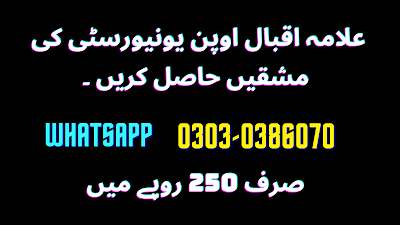Q.3 Describe the importance of the table of specifications also develop a two-way table of specifications for 50 50-mark paper by selecting any unit from 9th class general science.
Course: Educational Assessment and Evaluation
Course code 8602
Level: B.Ed Solved Assignment
Answer:
Table of Specification and its Importance
Designing a Table of Specifications
- Choosing the measurement goals and domain to be covered,
- Breaking the domain into key or fairly independent parts-concepts, terms, procedures, applications, and
- Constructing the table. Teachers have already made decisions (or the district has decided for them) about the broad areas that should be taught, so the choice of what broad domains a test should cover has usually already been made. A bit trickier is to outline the subject matter into smaller components, but most teachers have already had to design teaching plans, strategies, and schedules based on an outline of content. Lists of classroom objectives, district curriculum guidelines, textbook sections, and keywords are other commonly used sources for identifying categories for Tables of Specification. When actually constructing the table, teachers may only wish to use a simple structure, as with the first example above, or they may be interested in greater detail about the types of items, the cognitive levels for items, the best mix of objectively scored items, open-ended and constructed-response items, and so on, with even more guidance than is provided in the second example.
Objectives Teaching Testing
|
Standards |
Objectives |
Task Prompts |
Assessment Criteria (rubric) |
|
Reading 3.0: Read and respond to historically or
culturally significant works of literature and conduct
in-depth analyses of recurring themes.
Reading 3.2: Analyze how the theme or meaning of a
selection represents a view or comment on life, using textual evidence to
support the claim. |
SWBAT: •
Draw conclusions about literature through textual analysis. •
Respond in writing to recurring themes •
Use examples and quotes from the text to support their viewpoint on themes
in the literature. |
Pick one recurring heme from The House
on Mango Street. What do you think Cisneros is trying to communicate
through this personal narrative? Write a 4 paragraph essay on
this question and use textual evidence to support your thesis. |
Ideas: An essay is focused and uses interesting,
original details. The thesis is clear, convincing, and fresh. Supporting details
are accurate and relevant. Quotations are carefully selected,
thought-provoking, and support the thesis. The essay analyzes literature and shows a thorough understanding of the text |
|
Writing 1.3: Structure ideas and arguments in a
sustained, persuasive, and sophisticated way and support them with precise and relevant
examples. |
SWBAT: • Write an introduction that includes a hook,
thesis, and background information. •
Write organized body paragraphs containing textual support. •
Write an effective conclusion. •
Write transitions to connect ideas. |
Your introduction should include a hook,
thesis, and background information about the novel or novelist. Details
within each paragraph should support the main idea of each paragraph, and
these main ideas should contribute to your thesis. The conclusion should
restate your thesis and provide insight into the novel. Transitions should be
used to connect ideas between paragraphs. |
Organization: Strong organization highlights key
ideas. The Introduction is engaging and provides a clear direction. Details and
commentary are closely linked to the thesis. Body paragraphs are organized
and contain a strong balance between concrete details and commentary. Transitions
link ideas together smoothly and naturally. The conclusion is thought-provoking
and reinforces important Ideas. |
|
Writing 1.9: Revise text to
highlight individual voice, improve sentence variety and style, and enhance subtlety
of meaning and tone in ways that are consistent with the purpose, audience,
and genre. |
SWBAT: •
Use appropriate and effective words in writing. •
Vary sentence length and complexity. •
Write in a formal essay tone –avoiding casual and slang expressions. |
Check over and revise your work, or ask
for feedback from the teacher or peers. Make sure to use your own words in
describing your interpretation of the novel. Vary your sentence structures
and pick words that capture your ideas precisely. |
Style: Well-chosen words
convey the message in a precise way, adding new levels of understanding. Word
choice is explicit and vivid, and phrasing is memorable and readable.
Sentences are specific, strong, and vary in complexity and length. Words are
not wasted. Writing is fluid and strong. |
|
Conventions 1.1: Demonstrate control of grammar,
diction, and paragraph and sentence structure and an understanding of English
usage.
Conventions 1.2: Produce legible work that shows
accurate spelling and correct punctuation |
SWBAT: •
Write complete sentences with little to no grammatical errors. •
Produce legible work that shows accurate spelling and correct punctuation
and capitalization. •
Use MLA format. |
Pay attention to grammar, and use correct
spelling and punctuation. Make sure that you are using your words correctly.
Use the MLA format in citing references from the text or other texts. |
Conventions: An essay is essentially free from
grammar, punctuation, and spelling errors. Errors are so few and minor they
are easily overlooked. An essay is presented in the correct format. |



